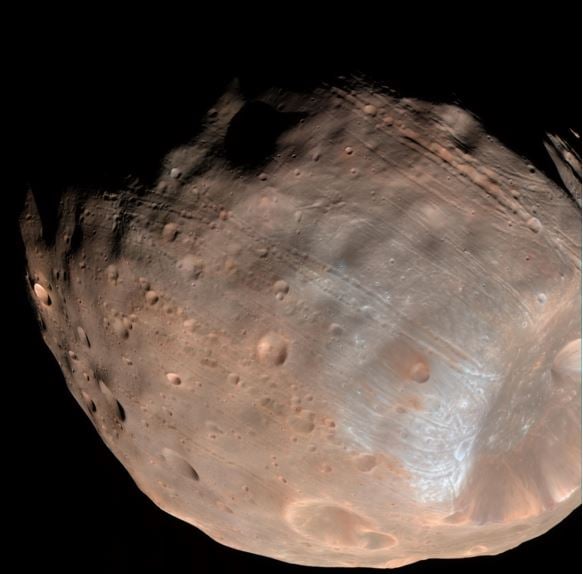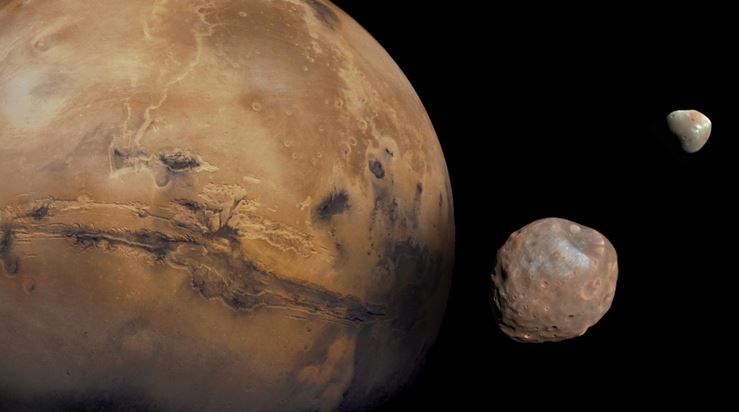Phobos, one of Mars’ two moons, has long, shallow grooves lining its surface that scientists at NASA’s Goddard Space Flight Center believe are the early signs of the structural failure that will eventually destroy it.
Phobos orbits Mars a mere 3,700 miles (6,000 km) above the Red Planet’s surface. It is much nearer its planet than any other moon in our Solar System. Compare it to the 238,900 miles (384,400 km) between Earth and our Moon.
Phobos, the larger of the two moons (the other one is called Deimos), is being drawn in by Mars’ gravity. Every hundred years it is about 6.6 feet (3 meters) closer. Within the next 30 to 50 million years, scientists believe Phobos will be pulled apart completely.
 According to the new modeling, Phobos’ grooves may be produced by tidal forces. (Credits: NASA/JPL-Caltech/University of Arizona)
According to the new modeling, Phobos’ grooves may be produced by tidal forces. (Credits: NASA/JPL-Caltech/University of Arizona)
Phobos has already begun to fail
Terry Hurford, who works at NASA’s Goddard Space Flight Center in Greenbelt, Maryland, said:
“We think that Phobos has already started to fail, and the first sign of this failure is the production of these grooves.”
Hurford’s and colleagues’ findings were presented at the annual Meeting of the Division of Planetary Sciences of the American Astronomical Society at National Harbor, Maryland, on November 10th.
For a long time, scientists had thought the grooves were fractures caused by an impact that formed Stickney crater. It was such a powerful collision that it nearly shattered Phobos. However, NASA’s team eventually determined that the grooves do not radiate outward from the crater itself, but from a focal point close by.
Tidal forces causing ‘stretch marks’
Some researchers have suggested the grooves might have been produced by several small impacts of material ejected from Mars. However, new modeling by Hurford and team supports the suggestion that they are more like ‘stretch marks’ caused by tidal forces that are deforming Phobos.
These tidal forces are caused by the gravitational forces between Phobos and Mars. Our Moon and Earth pull on each other similarly, producing ocean tides and making both moon and planet slightly ovate (egg-shaped) rather than a perfect sphere.
This explanation had been put forward for the grooves some decades ago, after the Viking spacecraft sent back images of Phobos. However, it was thought at the time to be more-or-less solid all the way through. When they calculated the tidal forces, they found that the stresses were to weak to fracture a solid mass of that size.
 Mars has two moons, Phobos (the larger one) and Deimos. (Image: svs.gsfc.nasa.gov)
Mars has two moons, Phobos (the larger one) and Deimos. (Image: svs.gsfc.nasa.gov)
Phobos is a pile of rubble inside
More recently, scientists have come to believe that Phobos’ interior could be a rubble pile, only just managing to hold itself together, surrounded by a layer of powdery regolith (unconsolidated solid material) about 330 feet (100 meters) thick.
Co-investigator on the study, Erik Asphaug, who works at the School of Earth and Space Exploration at Arizona State University in Tempe, said:
“The funny thing about the result is that it shows Phobos has a kind of mildly cohesive outer fabric. This makes sense when you think about powdery materials in microgravity, but it’s quite non-intuitive.”
With an interior like this, Phobos can easily become distorted. There is very little strength inside, and whenever anything pulls it, the outer layer is forced to readjust. Scientists think Phobos’ outer layer behaves elastically and accumulates stress, but it is weak enough that these stresses can cause it to fail.
This means that the tidal forces (gravitational pull) acting on Phobos can easily produce enough stress to fracture the surface. This model predicted stress fractures that line up very well with the images of Phobos.
This explanation also fits with the observation that some of the grooves are more recent than others, which would be the case if the process that is creating them is ongoing.
Neptune’s moon Triton, which is slowly falling inward and also has a fractured surface, will probably end up in the same way.
The researchers say their work also has implications for exoplanets, i.e. planets outside our Solar System that orbit a star.
Hurford said:
“We can’t image those distant planets to see what’s going on, but this work can help us understand those systems, because any kind of planet falling into its host star could get torn apart in the same way.”
